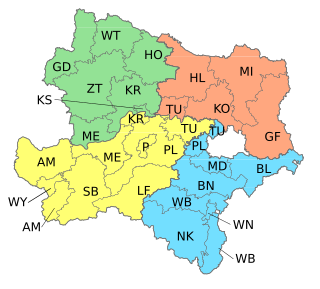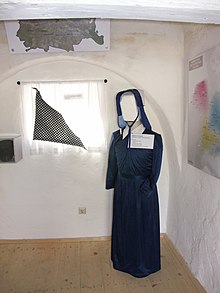Anabaptism is a Christian movement which traces its origins to the Radical Reformation.

Political identity came to the territory now occupied by the Principality of Liechtenstein in 814, with the formation of the subcountry of Lower Rhætia. Liechtenstein's borders have remained unchanged since 1434, when the Rhine established the border between the Holy Roman Empire and the Swiss cantons.

Hutterites, also called Hutterian Brethren, are a communal ethnoreligious branch of Anabaptists, who, like the Amish and Mennonites, trace their roots to the Radical Reformation of the early 16th century and have formed intentional communities.

Lower Austria is one of the nine states of Austria, located in the northeastern corner of the country. Since 1986, the capital of Lower Austria has been Sankt Pölten, replacing Vienna which became a separate state in 1921. With a land area of 19,186 km2 (7,408 sq mi) and a population of 1.685 million people, Lower Austria is the second-most populous state in Austria. Other large cities are Amstetten, Klosterneuburg, Krems an der Donau, Stockerau and Wiener Neustadt.

The Bruderhof is an Anabaptist Christian movement that was founded in Germany in 1920 by Eberhard Arnold. The movement has communities in the United States, the United Kingdom, Germany, Austria, Paraguay, and Australia.

Břeclav is a town in the South Moravian Region of the Czech Republic. It has about 25,000 inhabitants.

Mikulov is a town in Břeclav District in the South Moravian Region of the Czech Republic. It has about 7,700 inhabitants. The historic centre of Mikulov is well preserved and is protected by law as an urban monument reservation.
The Radical Reformation represented a response to perceived corruption both in the Catholic Church and in the expanding Magisterial Protestant movement led by Martin Luther and many others. Beginning in Germany and Switzerland in the 16th century, the Radical Reformation gave birth to many radical Protestant groups throughout Europe. The term covers radical reformers like Thomas Müntzer and Andreas Karlstadt, the Zwickau prophets, and Anabaptist groups like the Hutterites and the Mennonites.

Hustopeče is a town in Břeclav District in the South Moravian Region of the Czech Republic. It has about 6,200 inhabitants. It is known for fruit and wine growing.

The Weinviertel or Viertel unter dem Manhartsberg is located in the northeast of Lower Austria.

The House of Liechtenstein, from which the principality takes its name, is the family which reigns by hereditary right over the principality of Liechtenstein. Only dynastic members of the family are eligible to inherit the throne. The dynasty's membership, rights and responsibilities are defined by a law of the family, which is enforced by the reigning prince and may be altered by vote among the family's dynasts, but which may not be altered by the Government or Parliament of Liechtenstein.

Mistelbach an der Zaya is a town in the northeast of Austria in Lower Austria, one of Austria's nine federal states. It is located roughly 40 km northeast of Austria's capital Vienna. Furthermore, it consists of 8 subordinated municipalities.

Stockerau is a town in the district of Korneuburg in Lower Austria, Austria. Stockerau has 15,921 inhabitants, which makes it the largest town in the Weinviertel. Stockerau is also called "Lenaustadt" because the Austrian poet Nikolaus Lenau often spent time with his grandparents here.

The ruins of Falkenstein Castle is in the Weinviertel region of Lower Austria, about 55 kilometres (34 mi) north of Vienna near the border to Czech Republic.

Manhartsberg is a low, flat-lying mountain ridge in Lower Austria. It rises to a maximum height of 537 m. It is the southeastern flank of the granite Bohemian massif.
Sulz im Weinviertel is a town in the district of Gänserndorf in the Austrian state of Lower Austria. It is known for its open air museum in Niedersulz, the largest in Lower Austria.

The Margraviate of Austria was a medieval frontier march, centered along the river Danube, between the river Enns and the Vienna Woods (Wienerwald), within the territory of modern Austrian provinces of Upper Austria and Lower Austria. It existed from c. 972 to 1156.

Museumsdorf Niedersulz is an open-air museum in Austria that displays traditional buildings and architecture from the Weinviertel. It is located in the village of Sulz im Weinviertel, about 45 km north of Vienna in the province of Lower Austria. The Museumsdorf Niedersulz has over 80 original buildings and structures that have been transported from their original sites.

Gundakar of Liechtenstein was a member of the House of Liechtenstein and as such the owner of a large estate. He also served the Habsburg dynasty.

Wilfersdorf Castle is located in the Weinviertel in the town of Wilfersdorf, in the Mistelbach district. The castle and its estate have been continuously owned by the Liechtenstein family since 1436. It always served as a summer and hunting seat of the reigning princes. Today it also houses a cultural and exhibition centre as well as the property management offices of the princely estates in Weinviertel. It is renowned for its princely cellars. A well-known white wine is produced here on 38.5 hectares of vineyards.

















